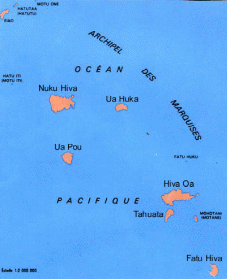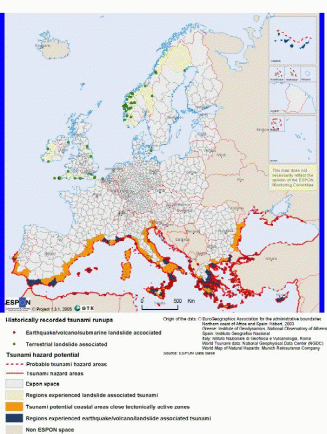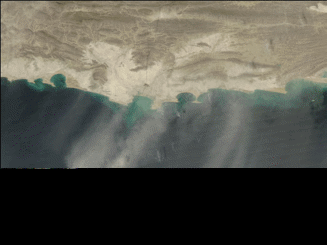Introduction
A hazard is a potential to cause harm, damage, breakage and destruction to property or even death to animals. It can also be a source of danger that is likely to result in an accident if undue care is not exercised. It can as well be considered a possibility of occurrence of a misfortune ( Raymond Agius, 2009). Other viable definitions include a situation posing a level of threat to life, health, property or environment. A hazard is equally considered anything that is unsafe or unhealthy that has or might cause people harm. It is an accident waiting to happen. Hazards are classified into the following groups: Physical hazards, biological hazards, Economic hazards and chemical hazards. Physical hazards are the forms of hazards most commonly experienced in the world. They include natural calamities and unsafe conditions which can cause injury, illness, suffering and even death.
A tsunami is a type of physical/natural hazard comprising of a series of waves, made in an ocean or other water body caused by an earthquake (earth movements), impact of a meteorite, landslides and even volcanic eruptions (Geology.com, 2005). Tsunami waves are very huge, long and destructive and may extend to 100 km along the ocean. The tsunami waves rise as they approach the shores of the ocean. These huge waves travel so fast and sometimes at 700 km/h. (Gardimer, Lisa, 2005) Tsunamis are also caused by sudden and abrupt motion of the ocean floor/crystal rock breakage and displacements, powerful volcanic eruptions and in some cases underwater landslides. Earthquakes occur at approximately 900,000 worldwide yearly (UpSEIS, 2007).
The most Tsunami prone areas in the US include areas of plate subduction. This is a zone where an oceanic plate is forced down the mantle by plate tectonic forces. There exists an enormous friction between the subducting plate and the overriding plate. The friction prevents any form of movement, including the sliding of the overriding plate leading to an accumulation of energy over a long period ultimately exceeding the friction leading to a sudden explosion and motion causing a tsunami. The moving wave, tsunami races away from the epicenter (area of earthquake occurrence/origin) gradually leading to destructive waves called the tsunami. The tsunami travels at an extreme speed over the open ocean reaching the continental lands faster than any meaningful control of its destruction (Geology.com, 2005). Tsunamis are also caused by rock falls and other impulsive generic sources.
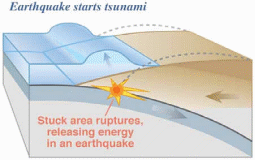
There are several ways of identifying the tsunami prone areas in the world. These regions normally lie along the shores of the oceans like the Pacific Ocean and Indian Ocean. This makes some of the U.S coastal cities casualties to the adverse effects of the tsunami. The Oregon coastal communities of 26 cities in the U.S face significant threats of tsunami occurrence and possible inundation due to the effects of the catastrophic phenomenon. These coastal lands are majorly accommodation and food services, retail trade, manufacturing and entertainment sectors. Any possible tsunami occurrence in this area may be very fatal and costly.
The Mid Eastern and the Eastern United States are believed to be most prone areas especially California and Alaska. These areas have also experienced considerable tsunami damages: Boston/ St.Ann, Massachusetts, New Madrid Missouri, and Charleston, South Carolina. World wide, the effects of the tsunamis are very well noted, documented, remembered and feared. Tsunamis have occurred repeatedly along the Pacific Ocean rendering Japan Eastern Asia and Sri Lanka. Other areas that are prone to the tsunamis include Midwestern and Eastern United States of America and parts of Eastern of Canada, Indian Ocean and East Africa.
The Tsunamis frequently occur in the Eastern parts of Asia’s Lanka and Japan. The Tsunamis recur with frequencies of short, medium, long, or super long cycles over a period of time. These occurrences may be irregular, intermittent and varying periodicity. Predictions of occurrence are not easy to make because of the difference in frequency levels. Events may occur in years, decades or hundred of years apart. However we can predicate with relative accuracy of where Tsunamis may occur in the future.(ESPON) Information on prediction may be useful for Tsunami risk assessment, disaster awareness and generally for pre-empted preparedness.
There are difficulties arising from making predictions of tsunami occurrence apart from the frequencies. These factors include: Knowledge of past events and tsunami occurrences may not be reliable, inability to detect the process of tsunami build up leading to warnings only after the tsunami waves have been detected. Besides, the technological inadequacies of most of these regions make it hard to invest in the detection and preparedness process, lack of fiscal resources, rudimentary understanding of the tsunami especially in the poor Nations, unpredictable processes and interactions. Exogenous and random conditions may interfere with the tsunamigenic earthquakes, inadequate historical data, difficulty of measuring the precursors to the tsunamis like the plate tectonic displacement rates.
Effects
Tsunamis have considerable effects on human health and wellbeing. Severe tsunami may lead to lose animal life including people, domestic and wild animals. For example the tsunami wave of 1997 in Java and Sumatra, killing 36,500 people. These fatal events leave very many people destitute, orphaned children and serious emotional ravages beyond repair. ( Gowrinathan, Nimmi, 2005) Tsunamis whether small or big may lead to a lot of infrastructural destruction in these regions of its activities. Some of the Infrastructure likely to be destroyed include: Residential and business premise, transport networks, Communications networks, recreational facilities, educational facilities and food reserve silos and stores. These factors have been discussed in-depth and how they are likely to lead to other problems and challenges.
Tsunamis may destroy residential premises like homes, cottages, castles and even tent houses. This may lead to loss of homes and destitution and more poverty to the communities of these regions. Tsunamis may destroy business premises like restaurants hotels, offices,motels, hostels, warehouses, stores and even museums and other recreational centres.These catastrophic events may lead to remarkably huge loses off property, finances and revenue sources. This in turn may lead to declaration of bankruptcy cases against those business people affected by the catastrophic.
The transport network of a country or region may be seriously destroyed due to the effects of the tsunami. Roads, railways, airports and tramways are some of the transport sector facilities likely to be affected in turn leading to a paralyzed transport sector. Educational and communication facilities may as well be affected leading to paralyzed communication even in times of need for relief assistance. Learning in schools, colleges and in public learning facilities may as well be affected. Electricity lines may as well be destroyed putting country into total darkness making service provision impossible especially in the health sector where electricity is needed round the clock.
Tsunami seriously erodes coasts of the areas of its activity. This may reduce beautiful tourist beaches to empty shells without any tourist value within a short period of time. A tsunami can cause flooding hundreds of meters inland rendering the land inhabitable and water borne disease infested beside destruction of crops and washing away of the top fertile soil. The inundation may as well lead to soil water logging and creating unnecessary marshes and temporary dams. The high speed of tsunamis may lead to the interference with marine life, fish, hippopotamus and plants. This leads to reduction in marine life population and poisoning of the water from the carcasses of the fauna and flora lives (Pararas, George 1986).
Tsunamis may lead to global itinerary interference and cancellation of voyages and flights to the affected areas. Due to flooding and damage of the ports and runways. Tsunamis may lead to deposition of huge boulders and rocks, sand and soil several meters inlands. This may destroy property and even block drainage systems. Tsunamis have serious impact on the ecosystem including air and water quality. Tsunamis may lead to pollution of ocean waters due to dead animal and plant life besides the impurities collected from the bottom of the ocean to the shores. The impurification of the waters may render human activities like fishing and sea faring impossible for a considerable time. Tsunamis may lead to internal displacement of people and massive migration from the affected areas
Whenever a tsunami occurs, there is a considerable damage on the ecosystem and the environment at large. The forests, trees, grass and other herbs are destroyed. The riverine plantation normally bears the brunt of the destruction. (Pararas, George 1986)These events may lead to deforestation and destruction of wind breakers. Tsunamis destroy physical entities on the land leading to cleared environment. Once the flood water goes away there may be drought. (Tsunamis Report,2008).
Preparedness
Due to the repeated occurrence of fatal, catastrophic and destructive tsunamis, several attempts have been made to control the extent of damage caused. World governments, on governmental organizations and other stake holders have put sizeable effort towards the control of these effects. Some of the preparedness measures taken by various stake holders include the following: Policy makers have legislated mounting of warning systems in case of disasters like the 2004, Asian tsunami. Printing of literary materials on tsunami issues, historical occurrences and other journal materials to make more people aware of the phenomenon ( Nimmi Gowrinathan, 2005). Documentation of data on tsunami has been improved and world libraries and archives are stocking these materials. More scientific studies are being done to acquire more information on these events (Bremer, Catherine, 2005).
Mangrove trees and other tree species are being planted in tsunami prone areas to reduce the tsunami impact on the mainlands and to reduce the rate of soil and sand erosion during the tsunami activities and to preserve the soil from further depletion.( Blackwell Publishing , 2007) Improved technological systems, tools and machines that are used to record the effects, magnitude and intensity of these events so as to predict future occurrences and effects. (Bremer, Catherine, 2005). More seismic monitory systems and offices have been put in places to predict on and warn on the phenomena. More public awareness is being done to create public confidence in the government warning systems. The various governments in the areas which are prone to the calamity need to improve evacuation systems and alternative housing strategies and post tsunami assistance and counseling programs for their citizens.
Even though the effects of the tsunami are serious and fatal, injuries have also been reported. Most injuries are mild with few cases of serious injuries in case impact with physical activities has been involved. This is because most of the effects of the tsunami are fatal because they involve drowning. (Pararas George, 1986) Information regarding tsunami should be readily available especially on the internet, resource books, documentaries, manuals and journals.
Conclusion
Despite the technological developments and historical records in our hands, we are still unable to provide appropriate prediction of the tsunami. We are further unable to provide timely reliable warning about the tsunami phenomenon. Based on these assertions therefore I would therefore recommend that improvements be made in the information and communication sector to improve prediction and develop sensitive and reliable warning systems. Communities and all the stake holders should put more effort and dedication towards the control of this calamity.
References
Blackwell Publishing Ltd. “Importance Of Mangrove Conservation In Tsunami Prone Regions.” ScienceDaily 2007.
Bremer, Catherine. Quake-Prone Mexico Ill-Prepared For a Tsunami. Planet Ark. Reuters. 2005.
ESPON, Natural Hazards. Tsunamis. 2005.
Gardiner, Lisa. What is a tsunami? Windows to the Universe. 2008.
Gowrinathan, Nimmi. Refugee Babies: The Lasting Effects of tsunami aid in Sri Lanka. UCLA International Institute. 2008.
Geology.com, Tsunami Geology-What causes a Tsunami? 2008. Web.
Thaindian News. New Study might determine explanation for tsunami prone zones. 2007.
Laczko F. and Elizabeth Collett. Assessing the Tsunamis’ effects on Migration. 2005.
Marquesas Island, 2000. Tsunamis.
Pararas, George. Effects of Tsunami on society. The Tsunami Page. 1986. Web.
Raymond, Aqius. Hazard and Risk. Definition. Health, Environment and Work. 2006. Web.
Robertson Delia. Effects of Tsunami Felt as Far as Southern Africa. Voice of America.com. 2004.
Rosenberg, Matt. Tsunami Preparedness. How To Prepare for a Tsunami if You Live in a Tsunami Risk Area. About.com. 2008. Web.
UpSEIS. Earthquakes in MidEastern and Eastern United States. MichiganTech. 2007. Web.

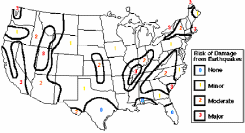
17.06.2006 Pacific Indonesia, Java 7,7 2,00 m 700 26.12.2004 Indian Ocean Indonesia, Off w. Coast of Sumatra 9,0 34,90 m 283.100 23.06.2001 Pacific Peru 8,4 7,00 m 26 26.11.1999 Pacific Vanuatu, Vanuatu Islands 7,5 6,00 m 5 17.07.1998 Pacific Papua New Guinea 7,0 15,00 m 2.182 17.02.1996 Indian Ocean Indonesia, Irian Jaya 8,2 7,70 m 127 14.11.1994 Pacific Philippines, Philippine Islands 7,1 7,30 m 62 04.10.1994 Pacific Russia, Kuril Islands 8,3 11,00 m k. A.
